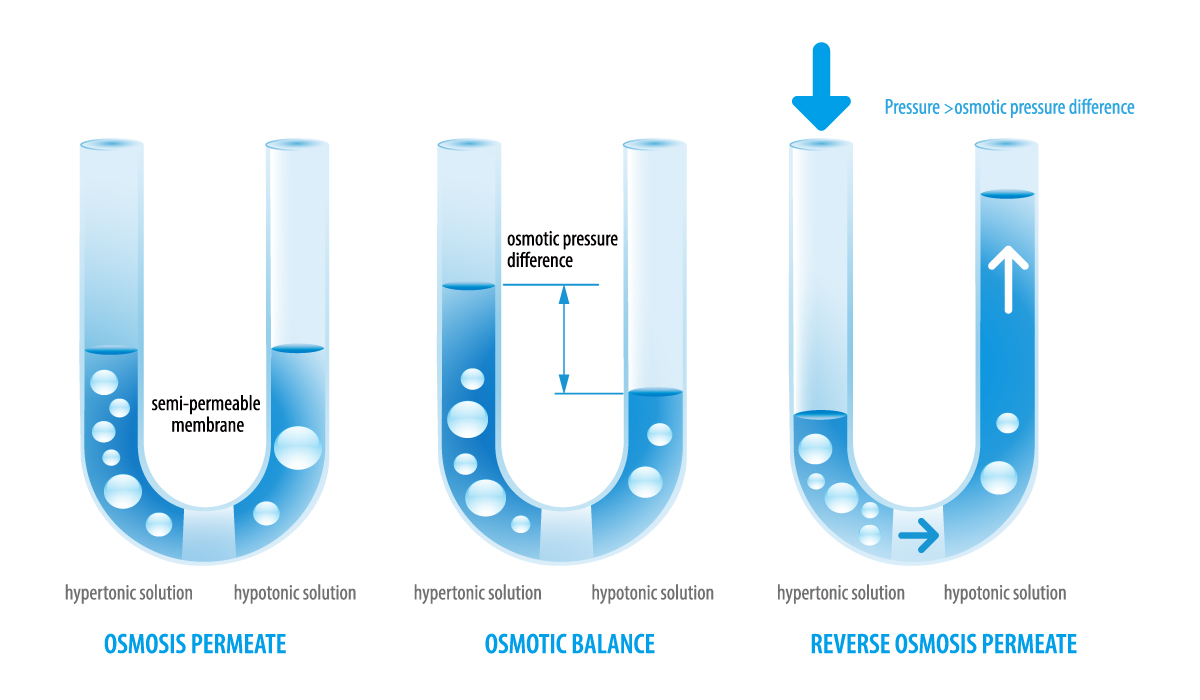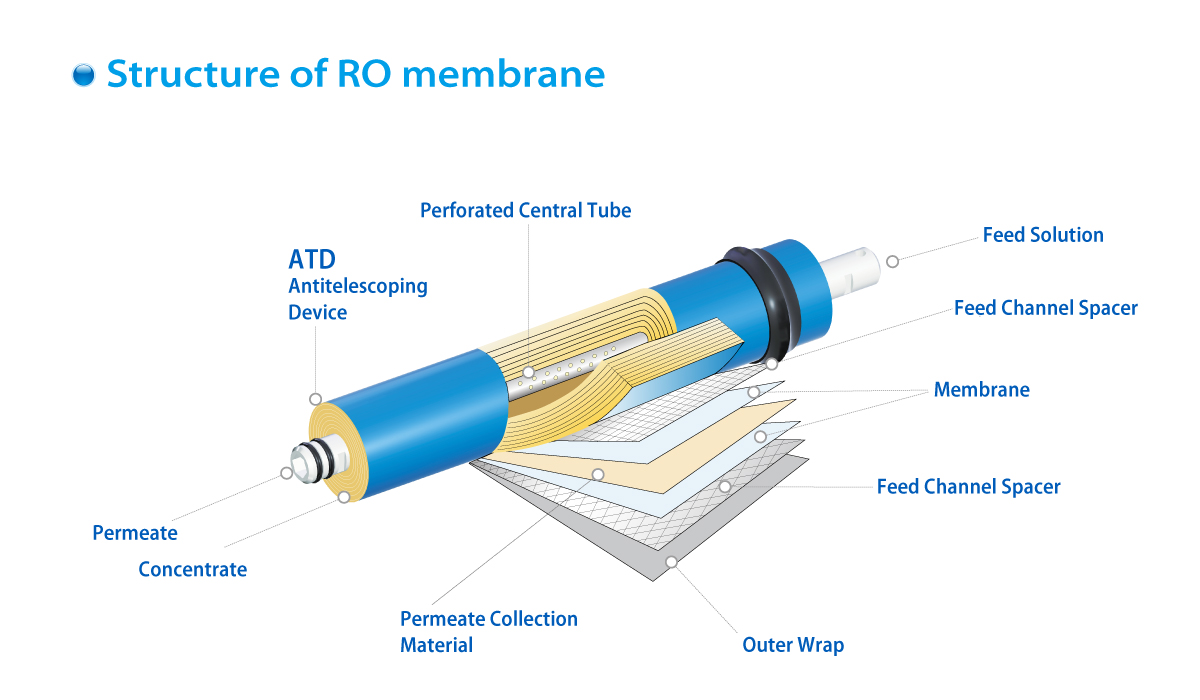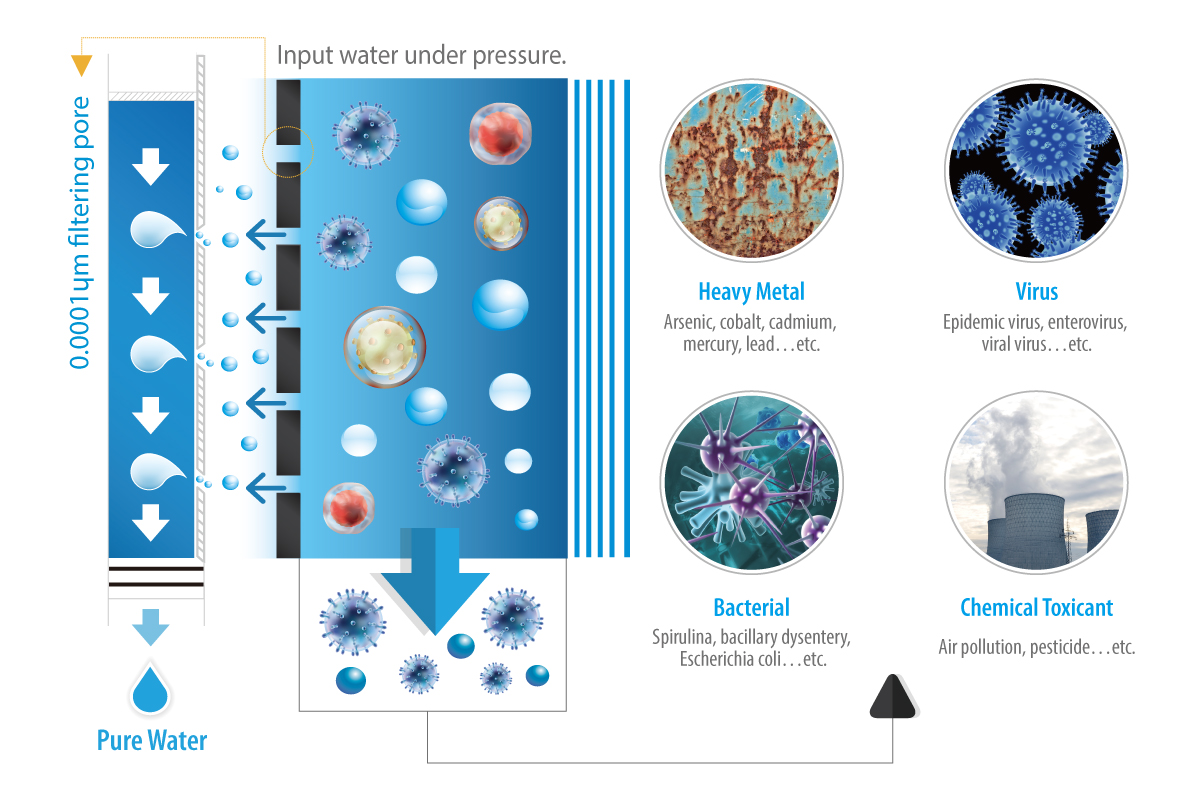Q1 What is Reverse Osmosis?
Definition of Reverse Osmosis is a water filtration process that uses pressure on a semi-permeable membrane to reverse the natural flow of osmosis. Osmosis is a natural process that takes place across many membranes in your body. Water can flow through the membrane, but salts cannot. If the salt concentrations on both sides of a membrane are different, water will flow through the membrane from the side with the lower salt concentration to the side with the higher salt concentration. This creates pressure on the side with the higher concentration. RO is a process that creates pressure on a solution of water with salt or contaminants, forcing pure water through the membrane where it is collected for use. Because the water is forced through the membrane in the direction opposite to what it would flow under normal osmosis, the process is called reversal osmosis, or RO for short.

Q2 What is the Difference Between Reverse Osmosis and a Regular Water Filter?
There are two major differences between reverse osmosis and filtration:
- Ordinary water filters physically screen dirt and sediment particles from the water down to about one micron but do not remove dissolved chemicals. Reverse osmosis uses a polymer membrane that filters down to the molecular level, removing dissolved chemicals and salts that a regular filter cannot remove.
- With a regular filter, all the water flows through the filter and the particles collect in the filter or on its surface, eventually plugging the filter. In RO filtration, instead of all the water flowing through the membrane, the feed water flows across the surface of the membrane. Pure water goes through the membrane, and as some of the remaining feed water flows across the surface of the membrane, it washes impurities away from the surface of the membrane, and out to the drain. This keeps the surface of the RO membrane continuously free from contaminants. This greatly extends the lifetime of the RO membrane and ensures the purity of the filtered water.
Q3 What is the RO Membrane Made of and How Does It Work?
The RO membrane is made of a very thin film (which does the actual filter separation) embedded on a layered supporting sheet. (Kind of like a thin sheet of plywood, with a very thin veneer) This configuration is known as the “Thin Film Composite” or TFC membrane. The membrane is rolled in a spiral configuration around a plastic tube, and pure water flows to the center tube where it is collected. Impure water flows across the surface of the membrane and out the end of the membrane tube to the drain.

Q4 What Contaminants Does Reverse Osmosis Remove?
The RO membrane will remove a minimum of 96% of organic contaminants and chemicals from the water. These include Pesticides and herbicides such as DBCP; industrial chemicals like PCBs, THMs, and TCE; heavy metals like lead, copper, zinc, and arsenic; nitrates, and other organics, etc.

Q5 Does RO Remove Sodium from Water?
YES! Reverse Osmosis was originally designed to desalinate seawater to be used for drinking.
For persons on a low-sodium diet, RO is the ideal process to use for removing sodium, especially from softened water.
To learn more about what else contaminants RO removes, welcome to read the related FAQ: What Contaminants Does Reverse Osmosis Remove?
Q6 Why Does an RO System Have Five or More Stages in the Filtration Process? What is the Purpose of Each Step?
The first filter is a 5-micron particle filter to remove dirt, rust, and other sediment.
The second filter is a carbon filter which removes organic chemicals, and most importantly, removes any chlorine from the water which can react with the RO membrane and damage it.
Third is a fine, 1-micron filter which further removes finer particles remaining after the carbon filter.
Fourth, the RO membrane, the heart of the system, will filter 95-99% of the dissolved contaminants from the water. The contaminants are washed down the drain, and pure water flows into a pressurized storage tank.
Fifth, after the storage tank and before the faucet, is another carbon filter to “polish” the water, removing any remaining odors or tastes.
If desired a remineralizing filter can be added as a sixth stage, or used in combination with the fifth stage carbon filter as a combination (fifth stage) “polishing-remineralizing” filter.
Q1 What Does Puricom RO Drinking Water Taste Like?
Because 95% or more of dissolved minerals and chemicals are removed, the RO water will have a pure plain taste similar to bottled water. If a taste similar to mineral or natural spring water is preferred, a remineralizing filter may be used for the final stage, to replace healthy minerals back into the drinking water giving the water a richer taste.
Because regular tap water contains contaminants that can mask the flavor of beverages prepared with water, you will find that using RO water to prepare beverages like coffee, tea, and juice drinks will bring out more of the natural flavors of these beverages.
Q2 Where Can I Install the Puricom RO Drinking Water System?
The system is usually installed under the kitchen sink, with a faucet next to the sink. It can also be installed in the basement with a tube to the faucet. If desired, a second tube can also be run to the refrigerator for ice and cold water, or to a second faucet.
Q3 How Much Water Does The Puricom RO System Produce?
With a standard 50 GPD (gallon per day) membrane, inlet pressure of 50 PSI, and water temperature of 25°C (77°F), the system will produce at least 50 gallons of drinking water per day. Using a system with a booster pump will increase the pressure on the membrane to over 80 PSI, giving up to 50% more product water and better contaminant removal. It should generally take less than half an hour (20 minutes with a booster pump) to collect a gallon of drinking water in the storage tank.
If a higher production rate is preferred, a 75 GPD or 100 GPD membrane may be used.
Q7 Factors that May Affect the Quantity and the Quality of the Water Produced
- PRESSURE. The greater the water pressure, the greater the quantity and better the quality of the water produced. Water pressure above 60 psi is ideal for systems without a booster pump. Using a system with a Puricom booster pump will ensure that the water pressure on the membrane remains above 60 PSI at all times.
- TEMPERATURE. 25°C (76°F) is the ideal water temperature for RO. If the water temperature is below 4°C (40°F) the production of RO will be about half that of water at 25°C (76°F). The maximum water temperature recommended is 35*C (95*F) to avoid damage to the membrane.
- TOTAL DISSOLVED SOLIDS (TDS). Generally, the TDS of tap/feed water will be under 500 ppm. (parts per million) If the TDS is significantly above this, the amount of water produced will decrease. Because the amount of contaminants removed is a percentage of the feed water, a higher TDS feed water will also give a higher TDS product water. If the level of TDS in the inlet water is too high, the volume and quality of the product water can be improved by increasing the pressure on the membrane with a booster pump.
- MEMBRANE. Different membranes are designed for different contaminant rejections, production rates, and resistance to chemical deterioration. Puricom can supply the proper membrane for your feed water conditions and filtration needs.
Q8 How Often Should the Filters and RO Membrane Be Changed?
It depends on the local water quality. The filter change time for all filters and the RO membrane can be adjusted to meet the local water conditions. Generally for water with under 300 ppm TDS, the following guidelines can be followed:
- Pre-filter PP5u: every 3 months
- Carbon: every 6 months. (Note: It is important to change this cartridge every 6 months to prevent chlorine in the feed water from damaging the membrane.)
- Sediment PP 1u: every 9 months
- RO membrane: every 2 years
- Post Carbon: every 12 months
For water with higher TDS, filters should be changed more often.
Q9 When Should the RO Membrane Be Changed?
If pre-filters are changed properly and on time, the membrane will last at least two years. If you notice a gradual reduction in water production, it may be caused by a layering of minerals and salts on the membrane surface. If you notice a gradual deterioration in the quality of water being produced, this could be an indication of damage to the membrane, and it should be replaced.
(Note: A TDS tester can be used to test the quality of the feed and product water to give a more accurate indication of when to change the membrane.
Q4 Do Puricom's RO Systems Have Any Quality Certification?
Puricom has passed ISO-9001 and some of Puricom's RO systems and components have passed CE, FDA, SGS, and Water Quality Association Gold Seal certification. Puricom's RO system uses the best quality components, and some of these components have passed NSF certification, such as Filmtec RO membrane, John Guest quick connect fittings and tubing, Calgon carbon…etc.* We insist on using the best quality materials and components for our systems. This is to ensure that our customers receive the best quality water purification systems.
*For more information on NSF Certified components, please contact sales@puricom.com
Q1 Are You a Trading Company or a Manufacturer?
We are a professional manufacturer in Taiwan of all kinds of filter cartridges and filtration systems. We provide you the total filtration solutions with our over 30 years of experience in the filtration field.
Q2 What’s Your MOQ?
Normally, 300 sets for RO systems and purifiers; 100 pcs for filters. Any trial order that is less than MOQ is warmly welcomed.
Q3 Can You Make Customized Products?
Yes, artwork and drawings will be provided by customers.
Q4 Can I Use Our Own Designed Package?
Yes, packing stuff can be customized. The printing plate fee for the OEM label and color box will be charged additionally.
Q5 May I Have Samples?
Yes, the sample cost can be refunded after you place formal orders.
Q6 What is Your General Lead Time?
Normally 5-10 working days for samples and 45 days for bulk production.
Q7 How Should I Place an Order?
Please send an inquiry or contact Puricom via email or telephone, our sales will recommend suitable products for your market and also provide some valuable suggestions for you.
Q8 How Should I Pay You?
We strongly recommend Trade Assurance service on the Alibaba platform. T/T, L/C, credit card, etc. are acceptable.
Q9 I am a Small Company Owner, can I Buy from You?
Yes, you are warmly welcomed. To grow with our customers is our goal. It will be our pleasure to support you and grow together.
Q10 What Certificate Do You Have?
Our factory is ISO9001 certified. Also, we have CE and RoHS certificates for the products we are manufacturing. For more details about Puricom's certifications, please visit Quality & Certification.
Q11 Since You are Famous, Can I Be Your Agent?
It’s our pleasure to have you join the Puricom family, we may discuss further to find the best way to cooperate in your market.
